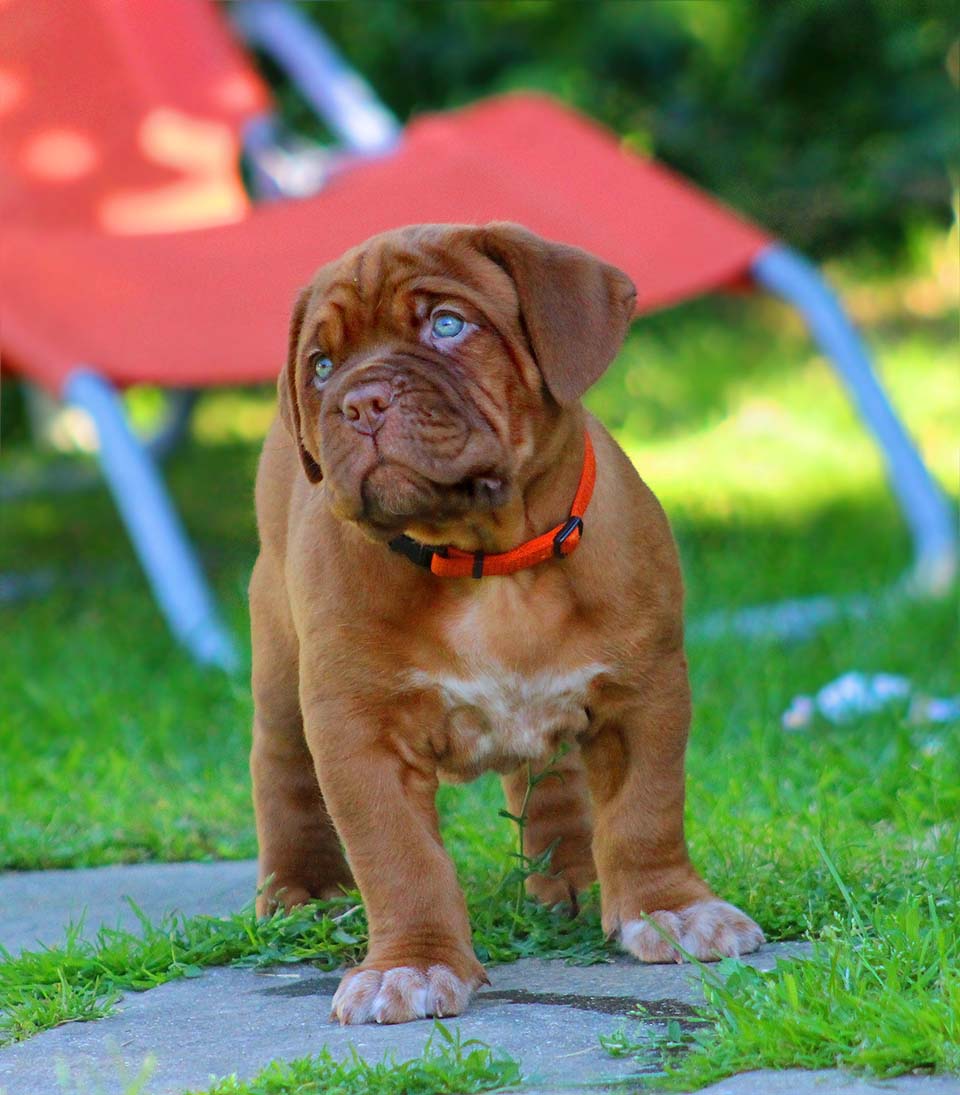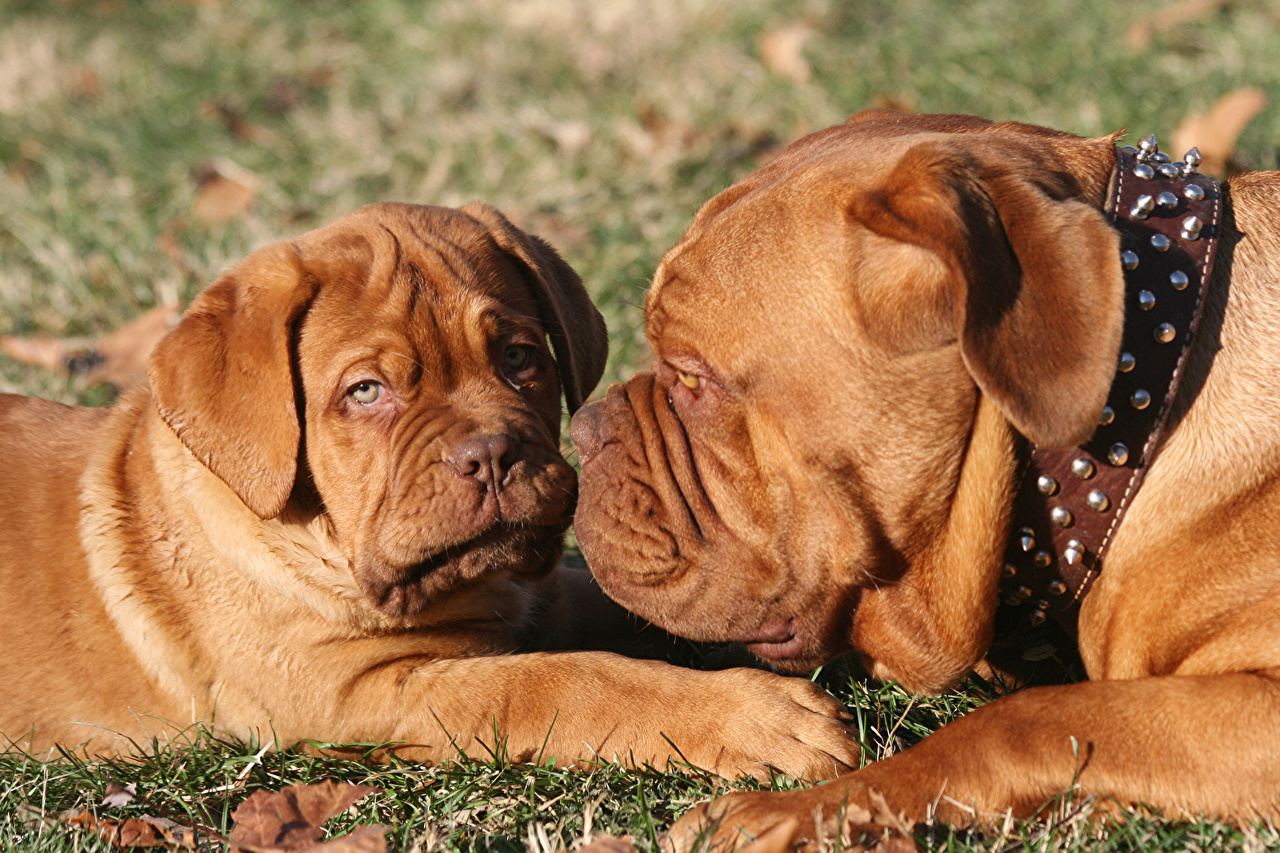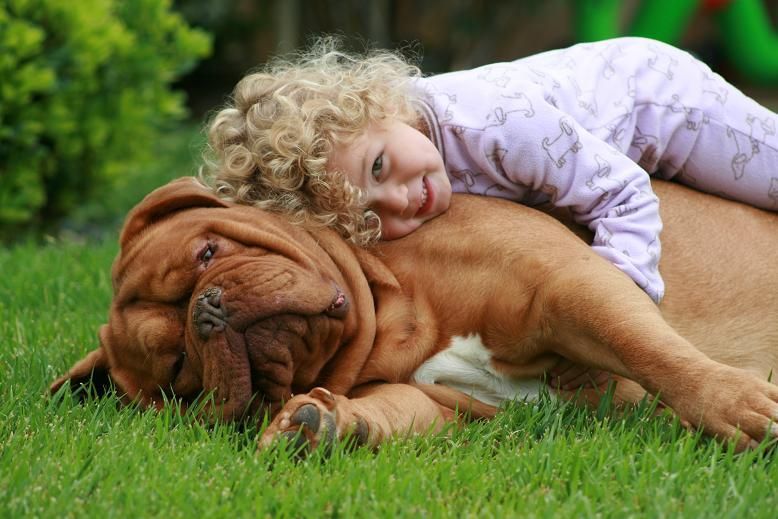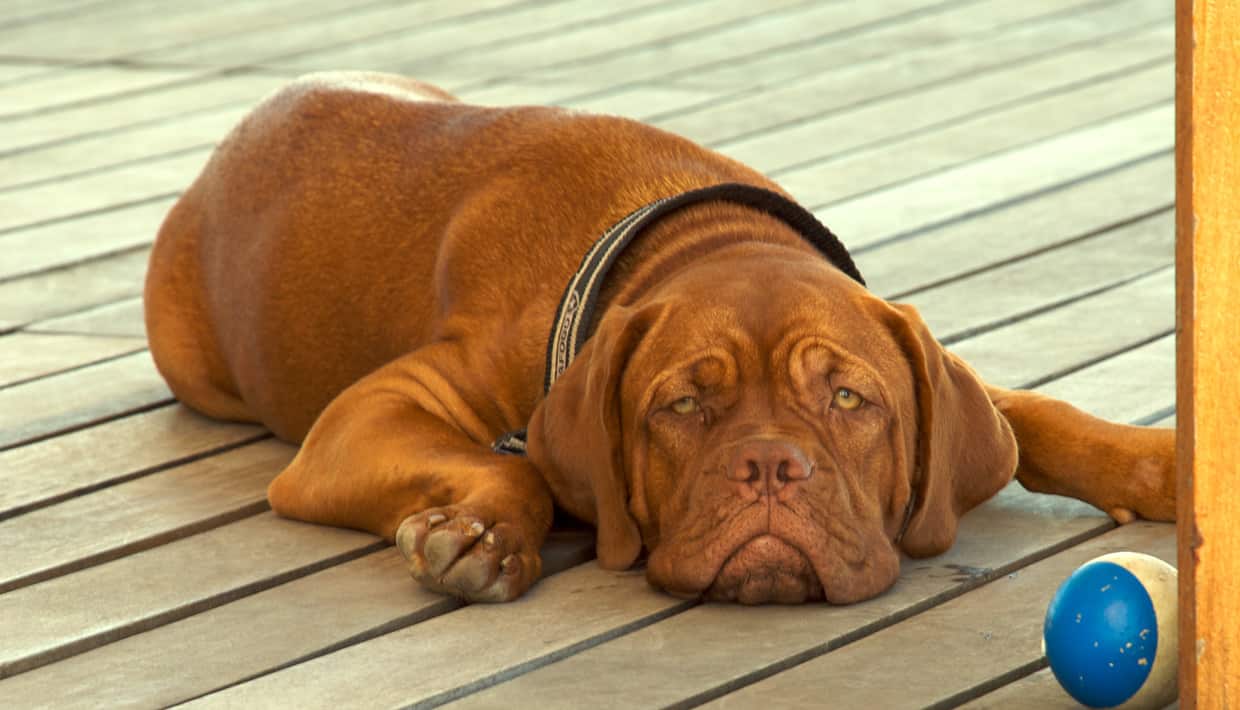El Dogue de Bordeaux it is one of the most impressive canines of all. His adult figure and colossal body hide a cool temperament that has captivated pet lovers. As always, here we will tell you everything you need to know about this friendly giant.

Origin of the Dogue de Bordeaux
The Dogue de Bordeaux, also known as Dogue de Bordeaux, has become one of the most esteemed Molossian dogs. This is due to the combination of his imposing appearance with his friendly temperament.
It is something that is curious, because most people cannot imagine that under that rough and even intimidating appearance, a sweet and faithful creature is hidden, capable of adapting to extremely diverse families.
However, if you are evaluating acquiring a specimen of this breed, it is good that you inform yourself sufficiently about the care they require. Learn about their education and other aspects related to their behavior. It depends on this, as it happens with all Large dog breeds, that the treatment between the creature and his new family is the best.
But to understand the Dogue de Bordeaux well, the first thing is to know a little about its origin.
The oldest tradition of this colossus is almost entirely unknown, but not a few connoisseurs agree on a possible Celtic origin. So it is estimated that in this nature-loving civilization, the huge dog was used for hunting big game and as a sort of bodyguard.
A multipurpose dog
But it was not until the fourteenth century that this breed was documented for the first time, in France. From then until the XNUMXth century it was a multipurpose creature. Because of its large size, it was ideal for hunting big game and as a guard. But it was also used for dog fights and as a butcher's assistant.
It is known that in those distant times there were three varieties of French Bulldogs: Dogo de Paris, Dogo Toulouse and Dogo de Bordeaux. The latter was the most direct predecessor of the current breed.
In 1863, the first dog show was held in the City of Light and the French capital. This was in the Acclimatization Garden and it also represented the debut of the Dogue de Bordeaux with its current name.
Physical characteristics of the Dogue de Bordeaux
If there is one feature that distinguishes the Dogue de Bordeaux, it is undoubtedly its colossal head. Some connoisseurs assure that among all the breeds of dogs, this creature of French origin has the largest head, in relation to its body.
To give you an idea, the pattern of the breed indicates that the cranial perimeter in the adult male must be -a little more a little less- equal to the height at the withers. While in the female it is estimated a little smaller, although it is also a remarkable head.
While the skin that covers its head is noticeably wrinkled, something that increases when the animal is paying attention. While the naso-frontal depression is extremely marked. This is because the snout makes an angle of almost 90° with the skull.
The nose is wide and pigmented, which will be in relation to the color of the mask. Its snout is thick, wide and short, which gives it the feeling of strength.
Its lower jaw, longer than the upper one, also identifies the breed. But also the lower jaw describes a parabola upwards.
The eyes are almond-shaped and well spaced from each other, with the particular hazelnut or brown color. Dark tones being preferred. Its small ears are somewhat darker than the mantle, with a high insertion and although they fall they do not become pendants.
His body and fur
The complexion of the Dogue de Bordeaux draws a rectangular shape, longer than tall, muscular and extremely strong.
The topline is straight and the chest powerful, very broad and deep. Its sides are somewhat retracted. While its tail is thick -especially at the base- and reaches the hock, without going beyond.
As far as the Dogue de Bordeaux's coat is concerned, it is short but thin and soft. It is blonde of any shade, being able to have white spots. Although for pure dogs they are only accepted on the forechest and at the end of the extremities.
The mask may well be black or brown, also known as a red or bistre mask. Although the mask may also not exist in these colossi.
Adult males can weigh around 50 kg, while their height is between 60 and 68 cm. In the case of females, they weigh at least 45 kg and their height will be between 58 and 66 cm.
Temperament and education of the Dogue de Bordeaux
Since all Dog breeds molossoids, the Dogue de Bordeaux is a dog with a lot of character that does not get nervous easily. He is balanced and calm in temper. He is not noisy and barks very little, let alone outrageously. But when he does it you have to take it seriously; maybe he is someone trying to sneak into the house.
This is a caste that exudes confidence. The Dogue de Bordeaux does not have to prove anything to other dogs, unless he is challenged.
Certainly the Dogue de Bordeaux is a breed with many charms, which is usually friendly both with people and with small animals. In such a way that it is perfect for children, although there are two very special reasons for this.
One of these reasons is that he loves being with people and a family will never seem very big to him. The other is that the Dogue de Bordeaux shows a lot of patience, so it will endure almost all the typical games, such as being pulled by the tail or any other nuisance of those that naughty children always invent.
Even these creatures are famous because they like to play in the most innocent way with the little ones in the house, such as putting on hats or wearing costumes.
However, it is an intelligent dog, to which it adds docility and generally does not like to fight. Unless, as we have already said, he feels challenged.
In addition, as the males are usually more dominant, on occasion they will be able to confront other canines to defend their domains. So dominance is a hereditary condition of these giants, which must be accepted and treated by their owners.
His protective nature
We must not forget that one of the first jobs of the Dogue de Bordeaux was that of protection, something that may require combat potential. In such a way that this colossus, true to his nature, can be aggressive. Being unlikely that he will provoke a fight, he will not easily back down from one and will defend what he considers his and his owners.
For this reason, the correct socialization of these furry giants is important. But still being sufficiently socialized, you have to be careful when they are with other dogs.
Likewise, the Dogue de Bordeaux is known for being a stubborn and haughty breed, but very ductile. Once one of these behemoths has learned an order, he will never forget it.
Due to their level of intelligence, it is required to continue beyond elementary obedience training. So if you are not going to use your Dogue de Bordeaux for hunting, work trials or other tournaments, it is best to keep it entertained with other occupations.
You may be surprised at how much you can learn to help you with everyday tasks. The best thing is that your colossal pet will never get annoyed.
When training your Dogue de Bordeaux, always keep in mind that it is a type of canine with a lot of self-confidence, that they can become arrogant and stubborn, but especially with excessive independence.
Already warned, it is not worth complaining, scolding him, much less punishing him as if it were a military training. With these colossal creatures, you can go further by mixing training with games. Remember that everything is easier, both for a dog and for its owner, when you learn or teach by playing.
Patience and more patience
El Dog training in a Dogue de Bordeaux requires patience, understanding and a bag full of rich prizes. It turns out that if the activity is supported with pieces of meat or other goodies, these colossal furry ones will learn more easily. In addition, the smell of food is known to have a magical effect to subdue his marked ego.
Constancy is also an element of value for the success of your education. It happens that if you can't stand his sad look and allow him to lie on the sofa, then you better forget about the sofa, because this one will soon be his.
Now, accepting that the puppy sleeps in your bed and feeding him when the family is at the table are similar mistakes.
Keep in mind that the adorable pup that snuggles up next to you will quickly transform into a colossal, fifty-pound, drooling dog that will take up the entire furniture or bed. But worse still, that he will not be willing to share such nice places.
The intelligence and independent personality of these dogs make many people think that they do not respond to the instructions given to them. Remember that everything is in the instruction and there is no need to be discouraged. Every year, countless of these animals successfully complete the obedience tests and compete well in those jousts.
You just have to exercise patience, use the rewards strategy and be mentally stronger than your pet. With this you will always be on top.
How is the Dogue de Bordeaux at home?
Despite being considered among the potentially dangerous dogs, this is a breed of willing dogs for work, who like to be with people and are quite cooperative. Despite his size, he is always a great addition to a happy family.
The Dogue de Bordeaux gets along well with other pets. Even if they are related from an early age, they can make good friends with cats, birds and other canines.
Although there could be problems if we put together two males with dominant personalities. So it is recommended that you have dogs of the opposite sex in the same house. But if you must have two males together, try to make the age difference between them as large as possible.
This is because not many young dogs will attempt to challenge the authority of an adult male. In addition, they will soon learn under the tutelage of the older dog.
The same recommendations apply to females. In both cases, it is recommended to present the puppy to the adult animal and wait attentively for the reaction of the latter. The integration of the offspring should not be forced if the adult canine reacts defensively.
When the mature does not accept the young, it will be convenient to discard the acquisition. This is because a stressful and continuous environment of conflict would be generated.
good with children
As with other pets, the Dogue de Bordeaux socializes well with infants, provided they are introduced in an appropriate and timely manner. Problems will almost never occur if the infant was already there before the pet's arrival.
In such a way that it is convenient to make sure that the infant does not assume an abusive attitude with the great pet. It happens that he becomes very attractive for a boy to annoy a placid Dogue de Bordeaux.
Although it is hard to believe, the supervision by adults is more necessary for the integrity of the dog than for that of the restless child.
The Dogue de Bordeaux is a docile creature from the inside, but apart from that he misses the affection of people. It is very unusual for an animal of this breed to be aggressive towards people, without being forced to do so.
race activity
Care must be taken when playing, training or exercising a young Dogue de Bordeaux. It happens that it is necessary to let the puppies rest when they require it. It is something easy to notice, because they are usually very curious and energetic. So when you notice him tired, let him rest.
The growth of the offspring of this caste is so fast that, as happens with all castes of colossal size, the ligaments have to withstand high tensions.
So when you go out for a walk with the puppy, it is best to impose a suitable rhythm on yourself. Increase the time and distance progressively in the initial months. Prolonged walks are only recommended after eight to nine months have elapsed, but you must always stay in tune with the physical condition of the puppy.
Let's not forget that most of the growth takes place during the first year of life. So once the necessary time has been fulfilled, there is no problem in a Dogue de Bordeaux going for a walk between 10 and 20 km. But yes, as long as it is not on an extremely hot day.
On the other hand, these types of dogs are very playful and are always ready for fun, even when it comes to an elderly animal. While chasing a stick or running after a ball might be a struggle for most of these behemoths, it's sure to be inexhaustible when it comes to playing with an old towel or empty sack.
Dogue de Bordeaux care
Taking care of one of these colossal creatures is quite simple. The first thing is brushing, which should be practiced occasionally, as it releases very little hair. But since it also gets little mud because it is a calm creature, the task will be even easier.
For that last reason, the bathroom is also not a problem. This will be done when it is really dirty or when it smells bad. In addition, it is not good to bathe him excessively, to take care of the oily mantle that naturally protects his skin.
Although we must emphasize cleaning your wrinkles, especially those on the face. It happens that these can keep food remains, saliva and any other dirt. In this way, the proliferation of fungi and other skin problems is avoided.
Another factor to consider about the Dogue de Bordeaux is that it requires at least three (3) walks a day. Remember that due to its size it needs to exercise, although moderately.
Finally, it cannot be forgotten that the Dogue de Bordeaux is considered a Potentially Dangerous Dog in several countries. So for this reason the use of the muzzle and leash in public places is forced.
Dogue de Bordeaux Health
Despite his obvious physical strength, this furry companion can get sick quite easily. In such a way that he will agree to visit the pet doctor at least twice a year. With this we will be able to detect any condition in a timely manner, which will improve your recovery.
Here is a list of the most common diseases in the Dogue de Bordeaux:
- Hip dysplasia
- Elbow dysplasia
- Gastric torsion
- Heatstroke
- Ectropion
- Aortic stenosis
- Conjunctivitis
- dilated cardiomyopathy
- Hypertrophic cardiomyopathy
- Mushrooms
- Allergies
On the other hand, it will be necessary to precisely comply with the animal's vaccination schedule. This prevents contagious and even serious conditions, including rabies, distemper and canine parvovirus.
Castration is also recommended, as this helps him to dispense with a natural impulse to mount with other males. This prevents the appearance of some diseases, while helping him improve his character even more.









